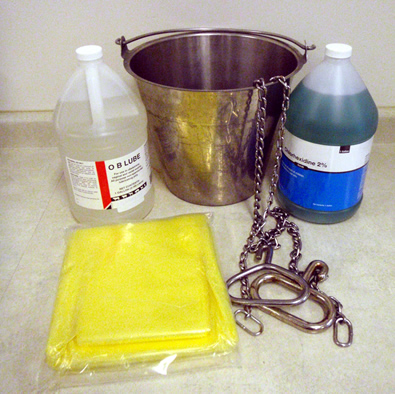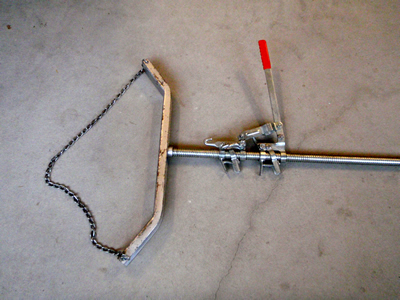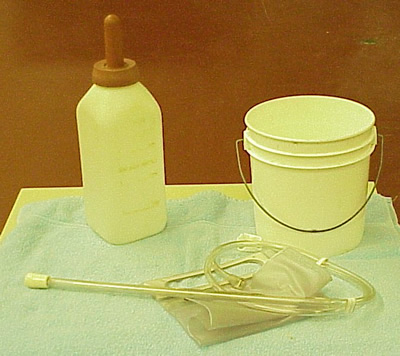Calving Management
Calving Supplies

Supplies
Stainless steel bucket, OB chains and handles, palpation sleeves,
chlorhexidine and OB lube.
Image credit: Grant Dewell
Calving supplies should be organized and on hand prior to initiation of the calving season. Obstetrical (OB) chains should be clean and free of rust. If using OB straps, make sure they are clean and in good shape. Be sure to clean and disinfect OB chains/straps and handles after each use. Palpation sleeves and latex gloves will help keep you clean and prevent contamination of the cow’s uterus. Use a disinfectant such as betadine or chlorhexidine in warm water to clean the cow prior to providing assistance.
Lubrication is a necessity to have on hand for calving. Females that have had a prolonged birthing process will have lost most of the fetal fluids that act as a natural lubricant. Generous application of an obstetrical lube can ease the delivery of the calf and prevent traumatic injury to the cow. Although other substances such as vegetable shortening or oil can work when nothing else is available, OB lube is less irritating to the reproductive tract and should be used whenever possible.
A calf puller can be an essential piece of equipment to have on hand and proper technique when using the calf puller is critical. Make sure the calf puller is clean and working properly. Friction based calf pullers (example: Frank’s calf puller) may fail if oil or grease has accidently gotten on the rod. Come-along style calf pullers should be checked to make sure the mechanism is not rusted and the cable is not frayed. Other equipment that can be valuable to have on hand includes a spotlight (or flashlight with extra batteries), nylon rope, halter, and a lariat.
Additional important equipment and supplies include esophageal feeders and calf feeding bottles. If the calf will not nurse from a bottle, then it should be tubed. When tubing a calf, proper technique (video) is critical to prevent injuring the calf or drowning it. Inspect the equipment prior to every use as a cracked esophageal tube can break when trying to tube a calf. Replace rubber nipples that are worn. Any calf born from a dystocia event should be fed colostrum, ideally obtained from the calf’s dam. In case fresh colostrum is not available, keep a few bags of colostrum replacer (greater than 100 grams of IgG) on hand.
Some producers purchase calf resuscitators to assist in saving very weak calves immediately after birth. Other supplies you should be using at the time of processing include a calving book, eartags, a scale to observe birthweight and elastrator rings if you castrate at birth. A sled, wheelbarrow or wagon should be readily available for moving calves. A thermometer to check temperatures, particularly in cold weather, is an important tool to help identify cold calves. If calving in extreme cold, calf blankets or ear protectors can be used to decrease cold stress and frostbite. A warming box may also be very helpful to warm cold calves. These boxes can be purchased or can be homemade. Barn lime can be valuable to use prior to rebedding dirt floored calving pens. Barn lime can help control disease causing pathogens by drying out the area and raising the pH.
Veterinary supplies that can be important to have on hand include syringes and needles, and chlorhexidine or other antiseptic solution to dip navels. In some cases, oxytocin can be useful to stimulate a cow’s uterus contract to prevent a prolapse and stimulate milk let down. Oxytocin may be obtained from your veterinarian. To treat scours in calves, have some oral electrolyte packages to help rehydrate calves.
| Contributors | |||||
|---|---|---|---|---|---|
| Grant Dewell | Renée Dewell | Katy Lippolis | |||
Associate Professor |
Veterinary Specialist Center for Food Security/Public Health rdewell@iastate.edu 970-231-9654 |
||||


